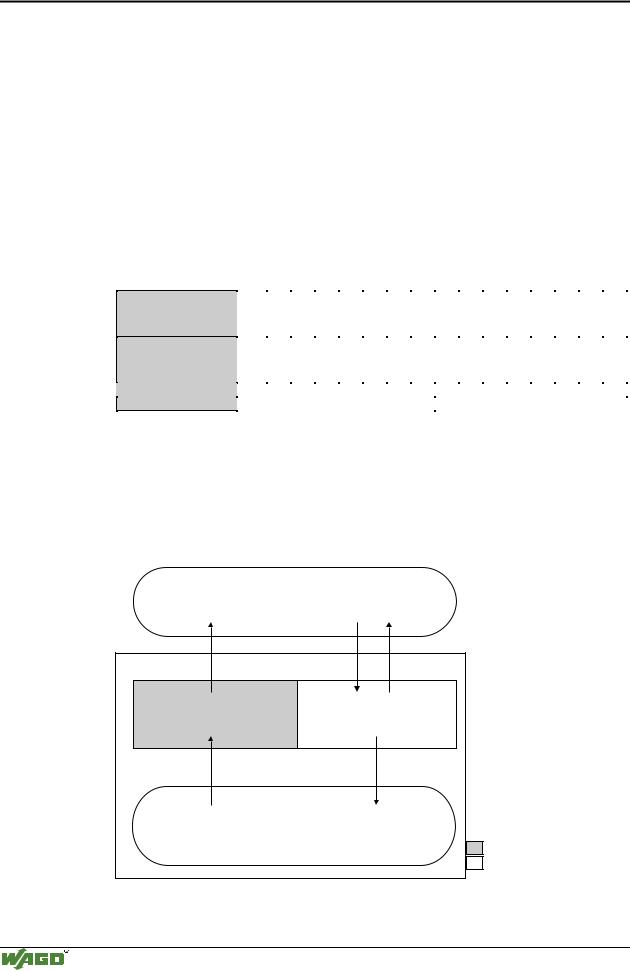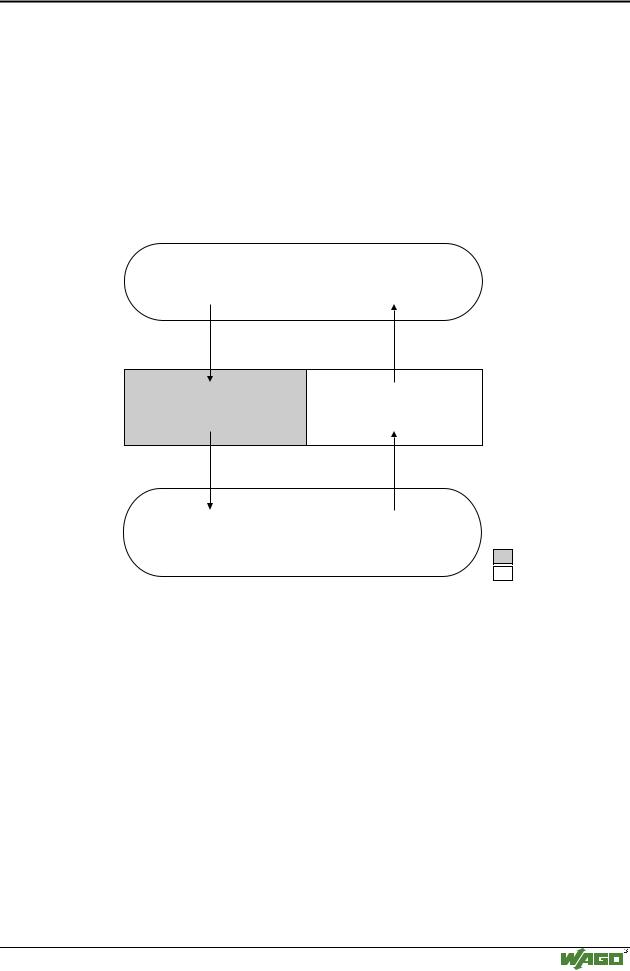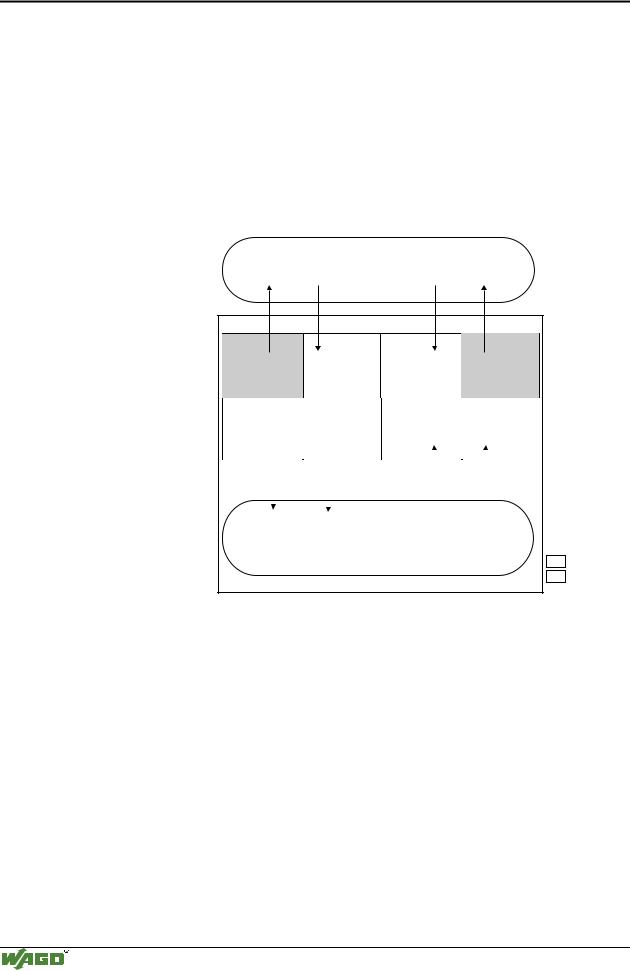
- •TABLE OF CONTENTS
- •Important comments
- •Legal principles
- •Copyright
- •Personnel qualification
- •Intended use
- •Scope
- •Symbols
- •Font conventions
- •Number notation
- •Abbreviation
- •The WAGO-I/O-SYSTEM 750
- •System Description
- •General
- •Coupler/Controller (1)
- •I/O Modules (2)
- •End Module (3)
- •Installation
- •Safty notes
- •Mechanical Installation
- •Electrical Installation
- •Wire Connection
- •Change fuse
- •Power supply
- •System supply voltage
- •Supply Voltage Field Side
- •Manufacturing Number
- •Technical Data
- •Fieldbus coupler / controller
- •Fieldbus coupler 750-342
- •Description
- •Hardware
- •View
- •Device supply
- •Fieldbus connection
- •Display elements
- •Configuration interface
- •Operating system
- •Process image
- •Example of a process input image
- •Example of a process output image
- •Process data architecture for MODBUS/TCP
- •Data exchange
- •Memory areas
- •Addressing
- •Data exchange between MODBUS master and I/O modules
- •Starting up ETHERNET TCP/IP fieldbus nodes
- •Connecting PC and fieldbus node
- •Determining IP addresses
- •Allocating the IP address to the fieldbus node
- •Testing the function of the fieldbus node
- •Reading out the information as HTML pages
- •LED Display
- •Blink code
- •Fieldbus status
- •Node status
- •Fault behavior
- •Fieldbus failure
- •Internal bus fault
- •Technical Data
- •Fieldbus controller 750-842
- •Description
- •Hardware
- •View
- •Device supply
- •Fieldbus connection
- •Display elements
- •Configuration and programming interface
- •Operating mode switch
- •Operating system
- •Start-up
- •PLC cycle
- •Process image
- •Example of a process input image
- •Example of a process output image
- •Process data architecture for MODBUS/TCP
- •Data exchange
- •Memory areas
- •Addressing
- •Data exchange between master and I/O modules
- •Data exchange between PLC functionality (CPU) and I/O modules
- •Data exchange between master and PLC functionality (CPU)
- •Common access of MODBUS master and PLC functionality to outputs
- •Address review
- •Starting up ETHERNET TCP/IP fieldbus nodes
- •Connecting PC and fieldbus node
- •Determining IP addresses
- •Allocating the IP address to the fieldbus node
- •Testing the function of the fieldbus node
- •Viewing the HTML pages
- •Programming the PFC with WAGO-I/O-PRO 32
- •LED Display
- •Blink code
- •Fieldbus status
- •Node status
- •Supply voltage status
- •Fault behavior
- •Fieldbus failure
- •Internal bus fault
- •Technical Data
- •I/O modules
- •I/O modules-Review
- •Digital Inputs
- •Digital Outputs
- •Analog Inputs
- •Analog Outputs
- •Supply and End modules
- •Terminal blocks for encoder and resolvers
- •Special terminal blocks
- •ETHERNET
- •Network architecture – Principles and Regulations
- •Transmission media
- •Network topologies
- •Coupler modules
- •Important terms
- •Network communication
- •Channel access method
- •Communication protocols
- •ETHERNET
- •IP-Protocol
- •TCP protocol
- •ICMP
- •Application protocols
- •MODBUS/TCP
- •Bootstrap Protocol (BootP)
- •HyperText Transfer Protocol (HTTP)
- •Common MODBUS functions
- •Use of the MODBUS functions
- •Description of the MODBUS functions
- •Function code FC1 (Read Coils)
- •Function code FC2 (Read Discrete Inputs)
- •Function code FC3 (Read multiple registers)
- •Function code FC4 (Read input registers)
- •Function code FC5 (Write Coil)
- •Function code FC6 (Write single register)
- •Function code FC7 (Read Exception Status)
- •Function code FC16 (Write multiple registers)
- •Function code FC11 (Get comm event counter)
- •Function code FC23 (Read/Write multiple registers)
- •Watchdog (Fieldbus failure)
- •Diagnostic function
- •Configuration function
- •Firmware information
- •General Registers
- •Special PFC Register (only for controller 750-842)
- •Application examples
- •Test of MODBUS protocol and fieldbus nodes
- •Visualization and control using SCADA software
- •Application in Explosive Environments
- •Foreword
- •Protective measures
- •Classification meeting CENELEC and IEC
- •Divisions
- •Explosion protection group
- •Unit categories
- •Temperature classes
- •Types of ignition protection
- •Classifications meeting the NEC 500
- •Divisions
- •Explosion protection groups
- •Temperature classes
- •Identification
- •For Europe
- •For America
- •Installation regulations
- •Glossary
- •Literature list
- •Index

70 • Fieldbus controller 750-842
Data exchange
3.2.5.3Data exchange between master and I/O modules
The data exchange between the MODBUS master and the I/O modules is made via the MODBUS functions implemented in the controller by reading and writing in bits or bytes.
The controller handles four different types of process data:
•Input words
•Output words
•Input bits
•Output bits
The word for word access to the digital input and output modules is made in accordance with the following table:
Digital inputs/ outputs
Prozess data
word
Byte
16. |
15. |
14. |
13. |
12. |
11. |
10. |
9. |
8. |
7. |
6. |
5. |
4. |
3. |
2. |
1. |
|
|
|
|
|
|
|
|
|
|
|
|
|
|
|
|
Bit |
Bit |
Bit |
Bit |
Bit |
Bit |
Bit |
Bit |
Bit |
Bit |
Bit |
Bit |
Bit |
Bit |
Bit |
Bit |
15 |
14 |
13 |
12 |
11 |
10 |
9 |
8 |
7 |
6 |
5 |
4 |
3 |
2 |
1 |
0 |
|
|
|
|
|
|
|
|
|
|
|
|
|
|
|
|
High-Byte |
|
|
|
|
|
|
Low-Byte |
|
|
|
|
|
|
||
D1 |
|
|
|
|
|
|
|
D0 |
|
|
|
|
|
|
|
Table 3.10: Allocation of digital inputs/outputs to process data word acc. Intel format
Adding 0x0200 to the MODBUS address permits to read back the outputs.
The register functions addressing can be by the means of the implemented MODBUS function codes (read/write). The individual register address is referenced instead of the address of a module channel.
MODBUS master |
||
0x000 |
0x000 |
|
|
(0x200) |
|
PII |
PIO |
|
0x0FF |
0x0FF |
|
(0x2FF) |
||
|
||
Inputs |
Outputs |
|
|
I/O modules |
|
|
PII = Process Input |
|
|
Image |
|
|
PIO = Process Output |
|
|
Image |
|
Programmable Fieldbus Controller
Fig. 3-27: Data exchange between MODBUS master and I/O modules |
g012929e |
Modular I/O System
ETHERNET TCP/IP

Fieldbus controller 750-842 • 71
Data exchange
3.2.5.4Data exchange between PLC functionality (CPU) and I/O modules
Through absolute addresses, the PLC functionality (CPU) of the PFC can directly address the bus module data.
The PFC addresses the input data with absolute addresses. The data can then be processed, internally in the controller, through the IEC 61131-3 program, whereby the flags are filed in a permanent memory area. Following this, the linking results can be directly written in the output data via absolute addressing.
Inputs |
Outputs |
I/O modules |
750-4xx....6xx |
%IW0 |
%QW0 |
PII |
PIO |
%IW255 |
%QW255 |
Inputs |
Outputs |
PLC functionality (CPU)
PII = Process Input
Image
PIO = Process Output
Image
Programmable Fieldbus Controller
Fig. 3-28: Data exchange between PLC functionality (CPU) and I/O modules |
g012943e |
Modular I/O System
ETHERNET TCP/IP

72 • Fieldbus controller 750-842
Data exchange
3.2.5.5Data exchange between master and PLC functionality (CPU)
The MODBUS master and the PLC functionality (CPU) of the PFC regard the data in a different manner.
Variables data created by the master reach the PFC as input variables and are further treated there.
Data created in the PFC is sent to the master through the fieldbus as output variables.
In the PFC the system can access the variable’s data as from I/O word address 256 (double word address 128, byte address 512).
MODBUS master
PII |
|
PIO |
PII |
0x000 |
0x100 |
0x000 |
0x100 |
|
(0x300) |
(0x200) |
|
Data from point of view |
|
|
|
|
|
I/O modules |
|
variables |
|
|||||||
I/O modules |
|
|
variables |
|
||||||||||||
of MODBUS master |
|
|
||||||||||||||
|
|
|
|
0x1FF |
0x0FF |
|
|
0x1FF |
|
|||||||
|
|
0x0FF |
|
|
|
|
||||||||||
|
|
|
|
|
|
(0x3FF) |
(0x2FF) |
|
|
|
|
|
||||
|
|
|
|
|
|
|
|
|
|
|
|
|
|
|
|
|
|
|
%IW0 |
|
%IW256 |
%QW0 |
|
|
%QW256 |
|
|
|
|||||
Data from point of view |
I/O modules |
|
variables |
I/O modules |
|
|
variables |
|
|
|
||||||
of PLC functionality |
|
|
|
|
|
|
||||||||||
|
|
|
|
|
|
|
|
|
|
|
|
|
|
|
||
|
|
|
|
|
|
|
|
|
|
|
|
|
|
|
|
|
|
|
%IW255 |
|
|
|
%IW511 |
%QW255 |
|
|
|
|
|
%QW511 |
|
|
|
|
|
|
|
|
|
|
|
|
|
|
||||||
|
|
|
SPS-PII |
|
|
|
SPS-PIO |
|
|
|
|
|
||||
|
|
|
|
|
|
|
|
|
|
|
|
|
|
|
|
|
|
|
|
|
|
|
|
|
|
|
|
|
|
|
|
||
|
|
|
Inputs |
|
|
|
Outputs |
|
|
|
|
|
||||
|
|
|
PLC functionality (CPU) |
|
||||||||||||
|
|
|
|
|
|
|
|
|
|
|
|
|
|
|
|
|
|
|
|
|
|
|
|
|
|
|
|
|
|
|
|
PII |
= Process Input |
|
|
|
|
|
|
|
|
|
|
|
|
|
|
|
|
Image |
|
|
|
|
|
|
|
|
|
|
|
|
|
|
|
PIO |
= Process Output |
|
|
|
|
|
|
|
|
|
|
|
|
|
|
|
|
Image |
|
|
|
Programmable Fieldbus Controller |
|
|
|
|
|
||||||||
Fig. 3-29: Data exchange between MODBUS master and PLC functionality |
g012944e |
|||||||||||||||
Data access by the MODBUS master
The data can only be accessed by the MODBUS master either word by word or bit by bit.
Addressing the data from the bus modules starts with word 0 for a word- by-word access, and also with 0 in word 0 for bit 0 for a bit-by-bit access.
Addressing the data from the variables starts with word 256 for a word-by- word access, and then, with a bit-by-bit access, addressing starts from:
4096 for bit 0 in word 256
4097 for bit 1 in word 256
...
8191 for bit 15 in word 511.
Modular I/O System
ETHERNET TCP/IP

Fieldbus controller 750-842 • 73
Data exchange
The bit number can be defined using the following formula:
BitNo = (Word * 16) + Bitno_in_Word
Data access by the PLC functionality
When accessing the same data, the PLC functionality of the PFCs uses a different type of addressing.
When declaring 16 bit variables, the PLC addressing is identical to the addressing of the MODBUS master made word-by-word.
When declaring Boolean variables (1 bit) a notation different to that of the MODBUS is used.
The bit address is composed of the elements word address and bit number in the word, separated by a dot.
Example:
Bit access MODBUS to bit number 4097 => bit addressing in the PLC <Wordno>.<Bitno> = 0.1
The PLC functionality of the PFC can also access the data byte-by-byte and double word-by-double word.
With the bytewise access, the addresses are computed according to the following formula:
High-Byte Address = Word address*2 Low-Byte Address = (Word address*2) + 1
With the access by a double word, the address is computed according to the following formula:
Double word address = High word address/2 (rounded off) or = Low word address/2
3.2.5.6Common access of MODBUS master and PLC functionality to outputs
The process illustration of outputs is described both by the MODBUS master as well as by the PLC functionality, so that the I/O module outputs can be set or reset from both sides. Design the user programs of the MODBUS master and the PLC functionality such that conflicting instructions for simultaneous setting or resetting of outputs is excluded.
Modular I/O System
ETHERNET TCP/IP
